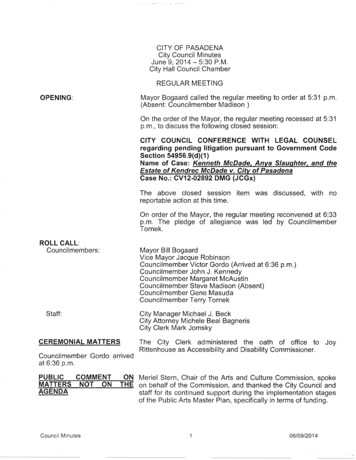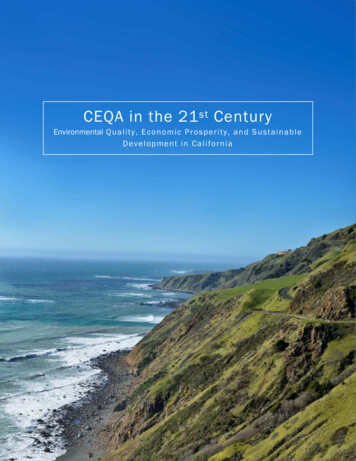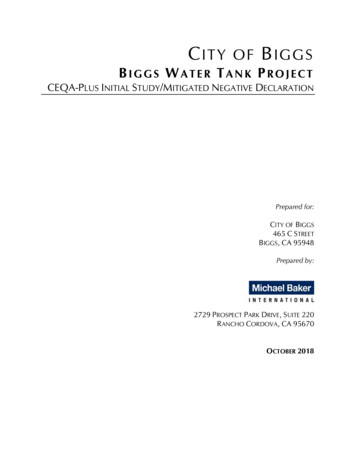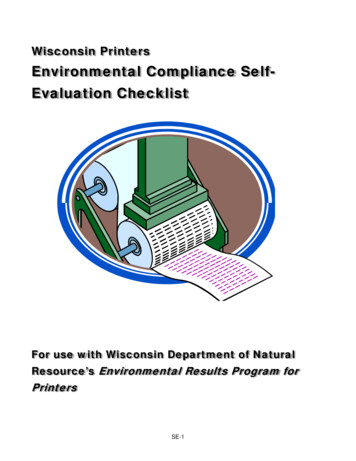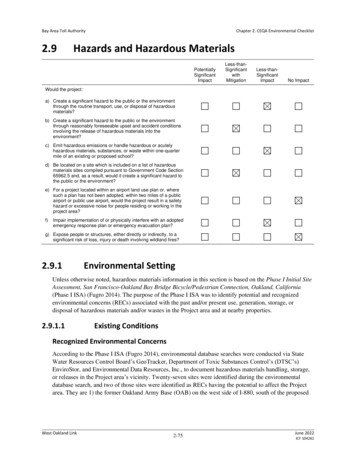
Transcription
Bay Area Toll Authority2.9Chapter 2. CEQA Environmental ChecklistHazards and Hazardous ificantwithMitigationLess-thanSignificantImpactNo ImpactWould the project:a) Create a significant hazard to the public or the environmentthrough the routine transport, use, or disposal of hazardousmaterials?b) Create a significant hazard to the public or the environmentthrough reasonably foreseeable upset and accident conditionsinvolving the release of hazardous materials into theenvironment?c) Emit hazardous emissions or handle hazardous or acutelyhazardous materials, substances, or waste within one-quartermile of an existing or proposed school?d) Be located on a site which is included on a list of hazardousmaterials sites compiled pursuant to Government Code Section65962.5 and, as a result, would it create a significant hazard tothe public or the environment?e) For a project located within an airport land use plan or, wheresuch a plan has not been adopted, within two miles of a publicairport or public use airport, would the project result in a safetyhazard or excessive noise for people residing or working in theproject area?f)Impair implementation of or physically interfere with an adoptedemergency response plan or emergency evacuation plan?g) Expose people or structures, either directly or indirectly, to asignificant risk of loss, injury or death involving wildland fires?2.9.1Environmental SettingUnless otherwise noted, hazardous materials information in this section is based on the Phase I Initial SiteAssessment, San Francisco-Oakland Bay Bridge Bicycle/Pedestrian Connection, Oakland, California(Phase I ISA) (Fugro 2014). The purpose of the Phase I ISA was to identify potential and recognizedenvironmental concerns (RECs) associated with the past and/or present use, generation, storage, ordisposal of hazardous materials and/or wastes in the Project area and at nearby properties.2.9.1.1Existing ConditionsRecognized Environmental ConcernsAccording to the Phase I ISA (Fugro 2014), environmental database searches were conducted via StateWater Resources Control Board’s GeoTracker, Department of Toxic Substances Control’s (DTSC’s)EnviroStor, and Environmental Data Resources, Inc., to document hazardous materials handling, storage,or releases in the Project area’s vicinity. Twenty-seven sites were identified during the environmentaldatabase search, and two of those sites were identified as RECs having the potential to affect the Projectarea. They are 1) the former Oakland Army Base (OAB) on the west side of I-880, south of the proposedWest Oakland Link2-75June 2022ICF 104261
Bay Area Toll AuthorityChapter 2. CEQA Environmental ChecklistLink, and 2) the Heroic War Dead Army Reserve Center11 on the west side of I-880, north of the proposedLink on the EBMUD site at 2400 Engineer Road.The OAB site was identified in the Department of Defense sites database, DTSC’s deed restriction listing(DEED), the CalEPA Hazardous Waste and Substances Sites Cortese List, and the State Water ResourcesControl Board’s Leaking Underground Storage Tank database.The EBMUD site was identified as part of DTSC’s Historical CalSites, DEED, State Response Sites, andEnviroStor database. It was also part of the State Water Resources Control Board’s Military Cleanup Siteslisting.Nearby SchoolsThe nearest school to the Project area is Ralph J. Bunche Continuation High School. It is approximately0.2 mile southeast of the intersection of Peralta Street and 20th Street (the southeast corner of the proposedClass II bike lane locations).Nearby AirportsThe Project area is not within an airport land use plan area or within 2 miles of a public airport or publicuse airport. The closest airport is Oakland International Airport, approximately 8.1 miles southeast of theProject area. San Francisco International Airport is approximately 14 miles to the southwest (across theBay), and Hayward Executive Airport is approximately 14 miles to the southeast. There are no privateairstrips in the vicinity of the Project.Wildfire RiskAccording to the “Very High Fire Hazards Severity Zones in LRA – Alameda County” map from the Fireand Resource Assessment Program, California Department of Forestry and Fire Protection (CAL FIRE),the Project is not within a High Fire Risk Area (CAL FIRE 2020). The area surrounding the Project area iscompletely developed and not intermixed with wildlands.Emergency Planning and Hazardous Materials ResponseThe City of Oakland is responsible for emergency planning/response and hazardous materials response.Oakland Fire DepartmentThe Oakland Fire Department (OFD) is responsible for hazardous materials response in the Project area.The OFD’s responsibilities include on-scene management of incidents involving hazardous materials, suchas accidental releases of toxic substances, industrial fires, and explosions involving petroleum productsand other chemicals. The hazmat team includes specialists from the City’s Office of Emergency Services(OES) to provide technical expertise in isolation, identification of chemicals, hazard assessment,containment, mitigation, decontamination, and disposal.The OFD’s Emergency Management Services Division (EMSD) is responsible for emergency planningand response in the Project area (City of Oakland 2014a). The EMSD’s responsibility is to ensure Oaklandis able to prevent, mitigate, prepare for, respond to, and recover from the effects of natural and humancaused emergencies. The EMSD coordinates activities related to planning, preparation, and11The Army Reserve named the site the Heroic War Dead United States Army Reserve Center and used the site forvehicle maintenance, medical equipment storage, logistics, and training.West Oakland Link2-76June 2022ICF 104261
Bay Area Toll AuthorityChapter 2. CEQA Environmental Checklistimplementation of the City’s Emergency Plan. The EMSD supports emergency response coordination ofOakland’s police, fire, and other first responders via the City’s Emergency Operations Center. The EMSDalso coordinates with the Operational Area and other partner agencies to ensure integration of federal,State, and private resources into local response and recovery operations.Oakland Office of Emergency ServicesThe Oakland OES assists local governments in their emergency preparedness, response, and recoveryefforts; serves as the conduit for federal disaster assistance; provides emergency information to the public;and coordinates the statewide mutual aid system. The Oakland OES, a division of the OFD, serves as theCertified Unified Program Agency (CUPA) for the city, enforcing federal, State, and local legislationrelated to hazardous materials and operates the City’s Emergency Operations Center.2.9.1.2Regulatory SettingRegulations applicable to contaminated soils affecting stormwater runoff are included in Section 2.10,Hydrology and Water Quality.Federal and StateFederal Toxic Substances Control Act/Resource Conservation and Recovery Act/Hazardous andSolid Waste ActThe Federal Toxic Substances Control Act (1976) and the Resource Conservation and Recovery Act of1976 (RCRA) established an EPA-administered program to regulate the generation, transport, treatment,storage, and disposal of hazardous waste. The RCRA was amended in 1984 by the Hazardous and SolidWaste Act, which affirmed and extended the “cradle to grave” system of regulating hazardous.Cortese ListU.S. Code 65962.5 (commonly referred to as the Cortese List) includes DTSC-listed hazardous wastefacilities and sites, Department of Health Services lists of contaminated drinking water wells, sites listedby the State Water Resources Control Board as having underground storage tank leaks or a discharge ofhazardous wastes or materials into the water or groundwater, and lists from local regulatory agencies ofsites with a known migration of hazardous waste/material.U.S. Department of Transportation Hazardous Materials Regulations (49 CFR 100–185)U.S. Department of Transportation Hazardous Materials Regulations cover all aspects of hazardousmaterials packaging, handling, and transportation. Parts 107 (Hazard Materials Program), 130 (Oil SpillPrevention and Response), 172 (Emergency Response), 177 (Highway Transportation) apply to the Projectand/or surrounding uses.California Health and Safety CodeDTSC, a department of CalEPA, is the primary agency in California for regulating hazardous waste,cleaning up existing contamination, and finding ways to reduce the amount of hazardous waste producedin California. DTSC regulates hazardous waste primarily under the authority of the federal RCRA and theCalifornia Health and Safety Code (primarily Division 20, Chapters 6.5 through 10.6, and Title 22,Division 4.5). Division 20, Chapter 6.5, of the California Health and Safety Code deals with hazardouswaste control through regulations pertaining to the transport, treatment, recycling, disposal, enforcement,and permitting of hazardous waste. Division 20, Chapter 6.10, contains regulations applicable to theWest Oakland Link2-77June 2022ICF 104261
Bay Area Toll AuthorityChapter 2. CEQA Environmental Checklistcleanup of hazardous materials releases. Title 22, Division 4.5, contains the environmental healthstandards for the management of hazardous waste. This includes standards for identification of hazardouswaste (Chapter 11) and standards applicable to transporters of hazardous waste (Chapter 13).Unified Hazardous Waste and Hazardous Materials Management Regulatory Program(Unified Program) (California Health and Safety Code, Chapter 6.11, Sections 25404–25404.9)This program consolidates, coordinates, and makes consistent the administrative requirements, permits,inspections, and enforcement activities of the environmental and emergency response programs andprovides authority to the CUPA. The CUPA is designed to protect public health and the environment fromaccidental releases and improper handling, storage, transport, and disposal of hazardous materials andwastes. This is accomplished via inspections, emergency response, enforcement, and site mitigationoversight. The CUPA for the City of Oakland is no longer the OFD OES. The California EnvironmentalProtection Agency (CalEPA) has designated the Alameda County Department of Environmental Health(ACDEH) as the CUPA for the City of Oakland (City of Oakland 2020).California Code of Regulations, Title 8—Industrial RelationsOccupational safety standards exist in federal and State laws to minimize worker safety risks from bothphysical and chemical hazards in the workplace. The California Division of Occupational Safety andHealth (Cal OSHA) and the federal OSHA are the agencies responsible for ensuring worker safety in theworkplace. Cal OSHA assumes primary responsibility for developing and enforcing standards for safeworkplaces and work practices. These standards would be applicable to both construction and operation ofthe Project. The standards included in the Cal OSHA’s Title 8 include regulations pertaining to hazardcontrol (including administrative and engineering controls), hazardous chemical labeling and trainingrequirements, hazardous exposure prevention, hazardous material management, and hazardous wasteoperations.California Labor Code (Division 5, Parts 1, and 7)The California Labor Code is a collection of regulations that include the regulation of the workplace toensure appropriate training on the use and handling of hazardous materials and the operation of equipmentand machines that use, store, transport, or dispose of hazardous materials. Division 5, Part 1, Chapter 2.5,ensures employees that are in charge of the handling of hazardous materials are appropriately trained on,and informed of, the materials they are handling. Division 5, Part 7, ensures employees who work withvolatile flammable liquids are outfitted in appropriate safety gear and clothing.California Department of Forestry and Fire Protection Fire Prevention ProgramThe program encompasses multiple diffe
storage, and disposal of hazardous waste. The RCRA was amended in 1984 by the Hazardous and Solid Waste Act, which affirmed and extended the "cradle to grave" system of regulating hazardous. Cortese List U.S. Code 65962.5 (commonly referred to as the Cortese List) includes DTSC-listed hazardous waste





